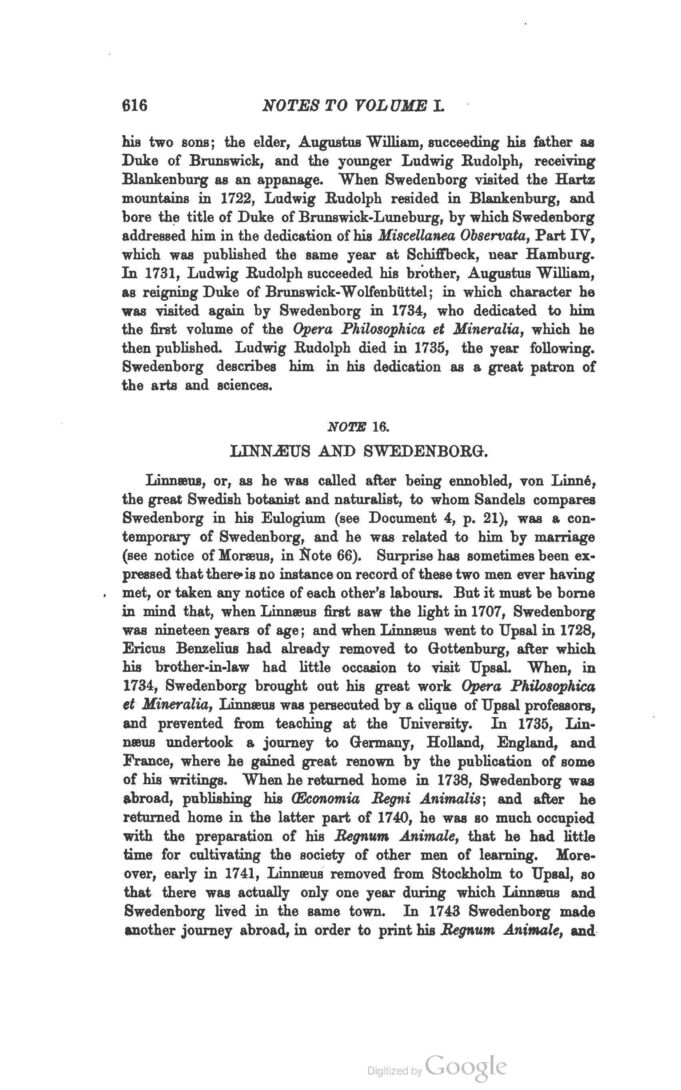
Full resolution (JPEG) - On this page / på denna sida - Sidor ...

<< prev. page << föreg. sida << >> nästa sida >> next page >>
Below is the raw OCR text
from the above scanned image.
Do you see an error? Proofread the page now!
Här nedan syns maskintolkade texten från faksimilbilden ovan.
Ser du något fel? Korrekturläs sidan nu!
This page has never been proofread. / Denna sida har aldrig korrekturlästs.
616 NOTES TO VOLUME I.
his two sons ; the elder, Augustus William , succeeding his father as
Duke of Brunswick, and the younger Ludwig Rudolph, receiving
Blankenburg as an appanage. When Swedenborg visited the Hartz
mountains in 1722, Ludwig Rudolph resided in Blankenburg, and
bore the title of Duke of Brunswick-Luneburg, by which Swedenborg
addressed him in the dedication of his Miscellanea Observata, Part IV,
which was published the same year at Schiffbeck, near Hamburg.
In 1731, Ludwig Rudolph succeeded his brother, Augustus William ,
as reigning Duke of Brunswick -Wolfenbüttel; in which character he
was visited again by Swedenborg in 1734, who dedicated to him
the first volume of the Opera Philosophica et Mineralia, which he
then published. Ludwig Rudolph died in 1735, the year following.
Swedenborg describes him in his dedication as a great patron of
the arts and sciences.
NOTE 16.
LINN ÆUS AND SWEDENBORG.
Linnæus, or, as he was called after being ennobled, von Linné,
the great Swedish botanist and naturalist, to whom Sandels compares
Swedenborg in his Eulogium (see Document 4, p. 21), was a con
temporary of Swedenborg, and he was related to him by marriage
(see notice of Moræus, in Note 66). Surprise has sometimes been ex .
pressed that thereis no instance on record of these two men ever having
met, or taken any notice of each other’s labours. But it must be borne
in mind that, when Linnæus first saw the light in 1707, Swedenborg
was nineteen years of age ; and when Linnæus went to Upsal in 1728,
Ericus Benzelius had already removed to Gottenburg, after which
his brother -in -law had little occasion to visit Upsal. When, in
1734, Swedenborg brought out his great work Opera Philosophica
et Mineralia, Linnæus was persecuted by a clique of Upsal professors,
and prevented from teaching at the University. In 1735, Lin
næus undertook a journey to Germany, Holland, England, and
France, where he gained great renown by the publication of some
of his writings. When he returned home in 1738, Swedenborg was
abroad, publishing his Economia Regni Animalis; and after he
returned home in the latter part of 1740, he was so much occupied
with the preparation of his Regnum Animale, that he had little
time for cultivating the society of other men of learning. More
over, early in 1741, Linnæus removed from Stockholm to Upsal, so
that there was actually only one year during which Linnæus and
Swedenborg lived in the same town. In 1743 Swedenborg made
another journey abroad, in order to print his Regnum Animale, and
<< prev. page << föreg. sida << >> nästa sida >> next page >>